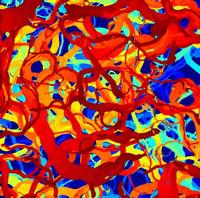 The soil dwelling bacterium Myxococcus
xanthus is an amazing organism that uses collective motility to hunt in giant
packs when near prey and to form beautiful and protective macroscopic
structures comprising millions of cells when food is scarce. I will present an
overview of how these cells move and how they regulate that motion to produce
different phases of collective behavior. Inspired by recent work on of active
matter and the physics liquid crystals, I will discuss experiments that reveal
how these cells generate nematic order, how defect structure can dictate global
behavior, and how they actively tune the Péclet number of the population to
drive a phase transition from a gas-like flocking state to an aggregated
liquid-droplet state during starvation.
The soil dwelling bacterium Myxococcus
xanthus is an amazing organism that uses collective motility to hunt in giant
packs when near prey and to form beautiful and protective macroscopic
structures comprising millions of cells when food is scarce. I will present an
overview of how these cells move and how they regulate that motion to produce
different phases of collective behavior. Inspired by recent work on of active
matter and the physics liquid crystals, I will discuss experiments that reveal
how these cells generate nematic order, how defect structure can dictate global
behavior, and how they actively tune the Péclet number of the population to
drive a phase transition from a gas-like flocking state to an aggregated
liquid-droplet state during starvation.

